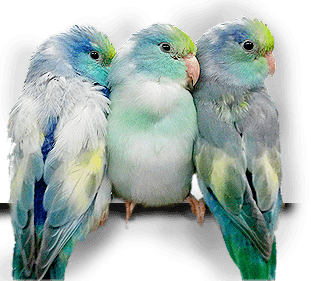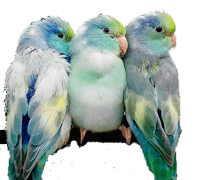Defensive Behavior and Juvenile Feeding Behavior
Baby birds that are naked and have been fed by their parents have normal behaviors designed to either obtain food or protect themselves from danger. The first is the begging/chirping that prompts the parents to regurgitate food. When the parents begins head-bobbing to keep the flow of food coming from the parent. Another normal behavior of baby birds is “swaying and growling” when the nest is disturbed. This behavior is self-defense designed to frighten away predators/intruders and will gradually cease as the bird weans.
Social Noise
In the wild, many species of birds congregate in the morning and again at dusk for social interaction. These activities include screaming, eating, and grooming. Birds resume these social activities at dusk. A common complaint in the pet home is that pet birds scream in the morning and evening. This is normal behavior of the bird and it may be unrealistic to expect it to change. The bird will consider the humans in its home as its “social contact”, and want to maintain “communication” it would normally have with other birds. Try using this time to interact with the bird. Social activity is an important part of the bird’s day and may serve to form a bond between you and the bird. The best attitude is to let the bird have its social noise and accept it as part of keeping a bird as a pet indoors. If the bird is kept outdoors try to prevent neighbor complaints by creating a sound buffer between the bird and your neighbors.
Biting
Birds bite, some more than others. Controlling or deflecting the biting reflex is the answer. Birds also bite to hold on to lift themselves up, like using a third hand. This is “grasping” rather than aggression biting. Birds bite in self-defense. Until a bird is tamed and accustomed to handling by humans, it will try to bite. Avoidance of the bite until the bird is conditioned to handling is the best response. If biting becomes a problem, consult your veterinarian for appropriate remedies and training.
Sleeping Habits
Many birds, especially smaller birds sleep comfortably hanging on the side of the cage or aviary by their beak and feet. Birds may also choose to sleep or bathe out in the rain unprotected in cold weather, and do not seem to suffer from the inconvenience. It is best not to disturb birds that have roosted outdoors for the night, no matter how uncomfortable they may appear, as they may not find another suitable perch before dark.
Inappropriate Copulating Behavior, Egg Laying
Birds that are not paired with suitable mates or that are bonded with their owners, may attempt unnatural copulation. The targets of this misplaced behavior are often cage fixtures, toys, human hands, or other species cagemates. Such behavior should not be encouraged. Seeking a same-species mate for the bird or removing the inappropriate object of the bird’s affection are the most common responses to this problem.
Egg-laying and breeding behavior can be modified through lighting, type of food, training, and restricting inappropriate handling. Your veterinarian can provide you with information on these behavior issues.
Birds ideally should be paired with a mate of the same species. It two species are paired that may produce hybrid offspring, it is best they be separated and properly paired. If the birds are cagemates where reproduction cannot possibly occur, such as a cockatiel and a budgie, the birds are of similar size and one is not injuring the other, no harm is done by permitting them to remain together.
Talking Birds
Some parrots and softbills talk, most do not. If you want to teach the bird a few words, it is best to separate it from other birds as early as possible, and teach it by repetition. Investigate which species are likely to talk before you purchase, if talking ability is important in your choice of a pet bird.
Feather Picking/Skin Picking
Birds that have underlying disease problems or psychological problems may pull feathers or tear at their own or another bird’s skin. The bird should be seen by your veterinarian at the first sign of feather picking. Watch for an unusual number of feathers on the bottom of the cage. This behavior is often precipitated by the absence of the primary owner, or by isolation or boredom. Birds with nothing to do all day are strong candidates for this disorder. If one bird pulling feathers from a cagemate, the birds should be separated as this behavior can sometimes lead to injury if feather pulling becomes to aggressive.
Moulting and Feather Loss
Normal moult is a semiannual event not related to behavior.
Obsessive Compulsive Behavior
If the bird develops a pattern of behavior that is nonsensical, incessant, or habitual such as pacing, head bobbing, rocking, swinging the head or body, or spinning, it should be examined by your veterinarian. Causes could range from disease to boredom. Disease should first be ruled out as a cause of obsessive behavior. Every attempt should be made to provide the bird with environmental enhancements such as toys, interesting foods, foraging toys. Non-toxic, non-injurious items that a bird can destroy or take apart are one choice.
Observation
Observation is the best tool for helping your veterinarian with a diagnosis. If the bird exhibits behavior problems, make notes or make a video to take to your veterinarian for evaluation. Birds will often continue to eat and drink when they are sick. This is called “Masking” and is used to hide a weakened condition from predators.


